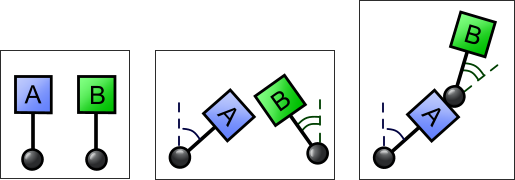Bongo 2.0 Inverse Kinematics
What is Inverse Kinematics?
When multiple objects are linked together with parent-child-relations the structure is called object hierarchy. In an object hierarchy parents usually transform their children as they are transformed themselves. These transformations are usually defined by rotation angles around pivot points, translations along pivot axis and axial scaling factors. Each object applies its parent's transformation to its own. This way all of the objects in the hierarchy get transformed. This method of applying transformation is called forward kinematics.
Sometimes it's necessary to set transformation for an object in the hierarchy by hand. Often this brakes the hierarchy because this object doesn't obey its parent's transformation anymore. To avoid breaking of the hierarchy some other objects have to adapt their transformations. This adaption is called inverse kinematics and it can be made to happen automatically.
IK View
If you right-click in the Animation Manager you can choose to enable the IK view. In the IK view you can see of which components and joint types the IK chain consists. The icons are the following:






